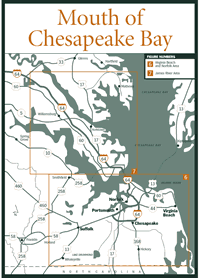
Before the first colonists sailed their wooden ships into the mouth of the
Chesapeake Bay, some 18,000 Nansemond, Algonquin, and Chesapeake Indians inhabited
the wooded coastal plains. They lived on oysters and fish from the rich waters
of the estuary, in addition to game from the forests and crops from the rich
soil. Remnants of oyster middens, grinding stones, and arrowheads around the
bay shores provide evidence of the Indian culture.
On April 26, 1607, Admiral Christopher Newport and a landing party from the English ships, Discovery, Godspeed, and Susan Constant, climbed the high sand dunes at Cape Henry. After the many long days at sea, the fragrant blossoms of springtime must have seemed like heaven.
Capt. George Percy, one of 28 colonists who came ashore, recorded his first impression of the New World: "There wee landed and (found) faire meddowes and goodly tall Trees; with such Fresh-waters running through the woods, as I was almost ravished at the first sight thereof." Capt. John Smith was aboard but was not part of the landing party because of a mutinous indiscretion that had landed him in the shipís jail.
The colonists later returned to the site and erected a wooden cross to mark this first landing, naming Cape Henry after much-loved Henry, Prince of Wales, who was then 13 years old. They claimed the land for England and conducted the Church of Englandís first religious ceremony in America.
The cape where the colonists came aground was at the mouth of a broad bay. They called the bay Chesapeakeó the same name used by local Indian tribes, a word thought to mean "great shellfish bay." The desolate dunes they climbed are now occupied by Fort Story, a U.S. Army base, and First Landing State Park.
Newport decided to travel farther inland to find a more protected site for the first colony and to build a capital city. On May 13, 1607, the ships landed on a small island in the James River. Named Jamestown after King James of England, the island became the first permanent English colony in the New World. The capital was later moved inland to Williamsburg.
Read and add comments about this page